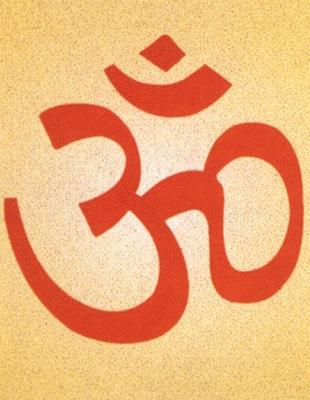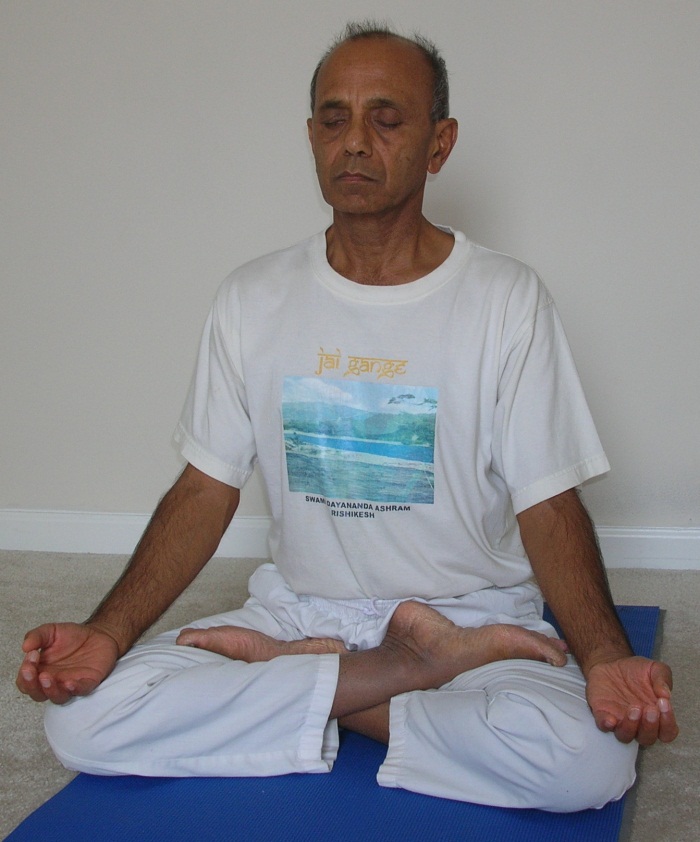
OM Symbol
If you have attended a yoga class, it is more than likely that the mantra OM was chanted at the beginning and/or the end of the yoga class. In the classes that I teach, we start the class by chanting OM three times. At the end of the class, we again chant OM once. In a previous blog post, I had written about the meaning and significance of OM.
Today I’ll be talking about another aspect of OM chanting – pranayama. When we chant OM, we take a deep breath in and while breathing out slowly, we chant the OM sound. In essence, then, OM chanting becomes a form of pranayama with a deep breathing pattern. We create the OM sound by constricting the passage of the outgoing breath. As a result of this constriction, we are able to prolong the duration of each exhalation. We can thus maintain the OM chant for a duration much longer than the natural breathing rhythm.
When OM is chanted as a pranayama, it is called the Udgitha Pranayama (उद्गीथ प्राणायाम). The word Udgitha is simply another name for OM. This word has been discussed in depth in the ancient scripture Chhandogya Upanishad (more about it a little bit later in this post).
When we chant OM at the beginning and end of the class, we usually start each OM chant together. For the most part, the students try to synchronize the chanting with the teacher. However, when we chant OM as Udgitha pranayama, we only pay attention to the sound vibration created by our own chanting. In this pranayama there is no attempt to synchronize the chanting with anyone else. In Udgitha pranayama, we get totally absorbed in our own chanting, the sound vibration of the chant, and the meaning and significance of Udgitha (OM). Because everyone has a different breathing capacity, everyone chants OM at their own pace making sure never to strain the breathing while doing the OM chant.
In my class, when we practice Udgitha pranayama, we normally chant OM for about 5-6 minutes. When we pause briefly between successive OM chants, we hear the most joyful sound that is coming from the other chanters, reverberating in the room and filling the surrounding atmosphere with the vibrational energy of the OM sound.
Step-by-step

Padmasana (Lotus Pose)
- Sit in any comfortable cross-legged sitting posture. Sukhasana (the Easy Pose) is perhaps the most common sitting posture used. However, if comfortable, you may attempt the Siddhasana or the Lotus pose. Choose a pose wherein you can stay perfectly still for the duration of pranayama and meditation.
- Keep the spine upright and tall. Keep the arms and shoulders relaxed.
- Keep the eyes closed throughout the practice.
- Take a couple of deep breaths, just making a connection with the breathing pattern.
- Now take a nice, deep inhalation. While exhaling, begin the OM chant, feeling the stomach being pulled in at the end of exhalation and the chant.
- Continue the practice for about 10-12 chants. As mentioned earlier, stay totally focused and tuned in to the sound vibration of the OM sound throughout the practice.
- When you finish the Udgitha pranayama, keep the eyes closed and continue to listen to the vibration of the OM sound filling your entire being with this pulsating energy.
How to chant OM
Here is the recommended approach to the chanting of the OM sound:
- Bring your awareness to the navel center (Manipura Chakra) in the region of the navel and feel as if the vibration of the initial "O" sound starts at the point in the spine which is in line with the navel center.
- Continue the "O" sound while slowly moving the awareness up the spine.
- When the awareness reaches the throat center, at the top of the spine, convert the chant to the humming "mmm…" sound of the OM chant.
- When you finish the OM sound, feel as if the vibration of the OM sound is filling the entire area of the crown center (Sahasrara Chakra).
- After each OM, pause for a brief moment, feeling the vibration of OM as if filling the whole body.
- Take the next inhalation and continue with the OM chanting.
Udgitha pranayama fills your mind with intense peace and tranquility and can be used as an effective means of getting into deeper states of meditation.
Significance of Udgitha
Now let’s get back to the significance of Udgitha as described in the Chhandogya Upanishad (CU). In my earlier post, I talked about the significance of OM as given in the Mandukya Upanishad (MU). As you may recall, in the MU it was mentioned that OM is in fact a composite of three letters A, U and M. A represents our experiences in the waking state, U represents our experiences in the dream state and M those in the deep sleep state.
Here is a very brief gist of the statements from CU which talk about the beauty and importance of Udgitha (extracted from an article on Wikepedia):
- The syllable OM is called by the term udgitha since a priest designated as Udgātṛ starts his singing of Sama Veda with OM in Vedic yajnas.
- Udgitha should be meditated as Vital Life Force or Prana.
- Udgitha should be meditated as Sun god.
- OM is the Eternal and Ultimate Refuge (Amritam, Abhayam) and that one who meditates this way becomes himself an Eternal and Ultimate Refuge.
- One who meditates on the Sun and its rays as separate from each other or Prana and its functions such as speech etc. as separate from each other would beget many children.
- Upasana (prayer) of udgitha brings wealth.
- OM (or udgitha) should be meditated as Purusha (Divine Person) present in the right eye who is nothing but another manifestation of Sun (Aditya) who in turn is another manifestation of OM.
- Udgitha result in a Superior Divine Essence in the practitioner.
- The three parts of Sama Veda – Prastava, Udgitha and Pratihaara are sung by priests in vedic rituals.
Namaskar Subhash ji,
Hope you are in a good shape.
I do Vipassana for meditation but I like OM chanting a lot. Can I do OM chanting as a Pranayama before my meditation? My intension behind doing OM chanting is just for deeper breathing. I don’t want to mix & match, combine or modify any thing. I will be doing Vipassana in its purest form.
Thanking You,
Rahul
Yes, Rahul, you can integrate the Udgitha (om chanting) pranayama as a form of “dharana” practice before transitioning to the Vipassana meditation.
The above advise has been sought for in ensuring my proper chanting of A U M
A AND U YOU BREATH OUT
WHILE CHANTING M YOU TAKE DEEP BREATH THRO NOSE TRAVELLING TO FOREHEAD AND RELEASING SLOWLY THRO NOSE
PL ADVISE IF THIS IS CORRECT
REGARDS
E S KUMAR
The way I practice and teach is to take a deep breath in and while exhaling chant the full AUM chant. I allocate about 2/3 of exhalation to the “O” sound and about 1/3 to the final “M” sound.
Is udgitha pranayama a form of meditation
Udgitha pranayama can be practiced as a form of dharana practice. As you may know, dharana (focus/concentration), dhyana (meditation) and samadhi are three stages of meditation. After practicing udgitha for some time as dharana, you can transition to your mantra meditation.
Guruji
Can we perform on chanting on exhaling and sheetala on inhaling.
Radhakrishna
Yes, Radhakrishna, it is perfectly OK to chant OM during exhalation and shitali (or sitkari) during inhalation.
hello,
do we make the mmmm sound through the nose or through the throat??
Thank you,
Raunak Singh
The sound is through the nose, mouth remaining closed.
Hello Sir,
I’m visiting your website last three days and I found it most helpful as I am collecting the all Prananayama methods. I found those techniques in simple way which I wasn’t able to found on others.
As this was my last method and I’m confused after reading such contradictory comments about this method. Can You please help me that what’s wrong with this method.SO, I can have the correct knowledge and the data.
Aiyeman, I am not sure what the real question is. Can you be more specific? Thanks.
Hi,
Can I chant OM while doing any work. I worry a lot and think a lot, i want to stop that. I try Breath watching awareness and other methods. but Now I want to try Om chanting while doing work or something. Is this right?
Hi Jyo, yes, you can chant OM at any time, while engaged in any activity. It should help you calm your mind. Thinking a lot is not harmful. It is worrying a lot that you need to work on.
Does addressing anyone as “Idiots” have a place in a discussion of sacred knowledge?
Hi Gayatri,
Labeling anyone with epithets like “idiot” shows the dominance of the ego (ahamkara) over intellect (buddhi). Practice of yoga should help resolve this problem over a period of time.
namaste sir,
your blog is very useful
please tell me how to breathe while chanting other mantras like gayatri mantra
Rohit,
I don’t know of any specific breathing guidelines while chanting such mantras. However, when I practice the Nadi Shuddhi (Anuloma Viloma) pranayama, I recite the gayatri mantra once during inhalation and twice during exhalation. That way I am able to maintain the recommended 1:2 ratio between inhalation and exhalation. You can give it a try.
I am a little confused by your reference to the word “amrita”. Where did you get this from?
Namaste Subhashji,
Breathing in the mouth is the answer. Again this is not breathing through the nose. UD-GI-THA (prana-apaana-vyaana) though small toungue breath towards brahmarandra and back to naabhi. This should generate Ushna(heat) like in yajna. You surely know about vaayuranila-mamrutamathedam basmaantham shareeram…
The naada generated through this is pranava naada. and amruta will flow when the fire(heat) generates.
My Guruji can explain it better. He is Bhaskarrao at Achyuta yoga near Bellary/Hampi.
https://books.google.co.uk/books?id=EAjre2OxyvIC&pg=PA545&dq=vayuranila&hl=en&sa=X&ei=y3gmVfKIN8r1UPmBgdAD&ved=0CCAQ6AEwAA#v=onepage&q=vayuranila&f=false
I will send the other links or I know you know it a lot better than me.
Best Regards
Arun
Hi Subhashji,
I feel the explanation given about udgitha is wrong. AUM is beeja mantra and the naada should be generated by pranava in yajurveda or udgitha in samaveda. praana and apaana kriya with vyana (silence) is praanaayama. Praana and apaana kriya should be done from naabhi to brahma randra and keeping little toung as a GURU media. Breathing through nose to lung is shwaasaayama.
Thanks, Arun, for your kind feedback. I appreciate your pointing out some potential limitations in the post. As I mentioned, I have taken excerpts from the Chhandogya Upanishad as the main source material. I would truly appreciate it if you could provide references to the other material that you have mentioned. I would like to read more about Udgitha and develop a deeper understanding.
It’s very good explanation Subhash ji, I could have started reading at the beginning your class hope I will visit here more frequently. I see some spells OM and some as AUM Is there any difference between these two ?
Thanks,
Jayanthy
Hi Jayanthy,
I am so glad that you found this article useful. There is no difference between AUM and OM. In Sanskrit, when letters A and U are combined they make the sound “O”. that’s why either spelling is fine.